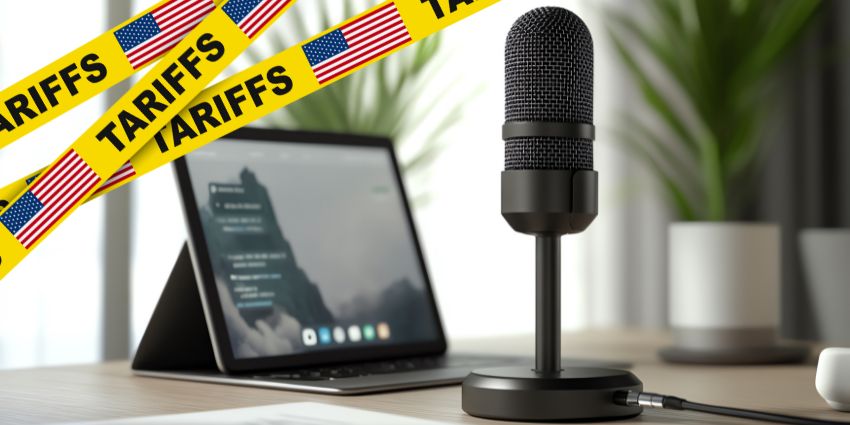If there can already be a word of the year for 2025, it’s tariffs.
Indeed, the Trump White House has pretty much got the whole world talking about them.
Being in UC, much of the major players have been spared any immediate impact from the currently announced tariffs, as the products produced are intangible.
However, like a microcosm of the world economy, the UC sphere has associated areas that could stand to be hurt by tariffs, creating a knock-on effect for the sector as a whole.
AV, with its parts made in one place, manufactured in another, and sent to another to be purchased, is at risk of being hit by the tariffs in a significant way.
But how can AV adapt to this new reality, and where might they get hit the hardest?
Examining AV’s Relationship with UC
AV products are essential to the UC ecosystem because they bridge the gap between digital and physical collaboration, enabling seamless real-time interactions.
Many people who use UC platforms like Teams do not use it just for meetings between remote staff, but to link the in-office and remote workers together.
As a result, integrated AV solutions, such as video conferencing systems, interactive whiteboards, and digital signage, have become essential for keeping that line of communication open and efficient, which is critical for remote and hybrid work environments.
Thus, many companies will not only subscribe to a UC platform, but will buy associated products – like physical devices optimised specifically for Teams – that can help work in tandem with that to make hybrid meetings work better.
AV’s Supply Chain
AV, like many electronic products, has a interconnected, global supply chain where manufacturers, suppliers, and distributors collaborate to produce and deliver both components and end products.
For instance, China is the hub for processing these materials and bulk manufacturing, Vietnam and Malaysia handle mid-stream tasks like assembling circuit boards or molding plastic parts; raw materials like carbon or piezoelectric crystals from Africa or Australia, which are then refined in places like China, Japan and South Korea.
Looking at Trump’s tariffs, almost everyone on the above example has been tariffed.
However, many of the most critical stops on that supply chain have been hit the hardest with tariffs.
Goods from Japan have been hit with a 24 per cent tariff, 25 per cent from South Korea, 32 per cent for Taiwan and now a total of 54 per cent for China.
Avocor’s CEO Scott Hix told AVNetwork in March, amid murmurings of tariffs that has “products that are built in multiple locations around the world.”
This includes Taiwan where AUO are headquartered, China, South Korea, and Europe, and all countries that have been hit with tariffs.
Although you would think being spread out like that means they open themselves up to a big hit, Hix highlighted how this can help them at least avoid the worst of the tariffs.
“We have the ability to move rapidly and leverage our Taiwan infrastructure very efficiently to eliminate as much of the tariff impact as possible,”
he said.
However, for smaller vendors, this ability to organise it so you are getting hit by the lowest tariffs, may not be an option available to them.
“We have options that I don’t think everyone has right now,”
Hix said. “We just happen to have the benefit that we can be a lot more nimble because of our strength of factories, which includes Taiwan since that’s where our headquarters is located.”
The Knock-on Effects
A rising tide lifts all ships, the adage goes. Yet, so can be said for the inverse.
Trump’s tariffs have hit the so called Magnificent 7 cohort of tech companies hard, with Meta, Apple, Amazon, Nvidia, and Tesla having all suffered 12 per cent and 16 per cent.
Microsoft, on the other hand, has weathered the tariff tidal wave far better than its peers; Microsoft’s stock price went down roughly 5.8 per cent from its closing price on Wednesday, the evening of the tariff announcement.
This is believed to be, as mentioned above, because Microsoft doesn’t deal much in physical or consumer products—so it has less direct exposure to tariffs.
However, if consumers of its products are hit with increased costs with buying associated meeting room tech, that could see them pull back spending elsewhere.
That would be bad news for a company like Microsoft, which has plowed billions into AI in the pursuit of profit and has still yet to satisfy investors with its yield.
An increase in cost in one area of a company’s UC solutions could see a reduction in the other, especially as companies like Microsoft increased the cost of their subscription to its 365 packages.
Just like the global economy, the relationship between AV and UC is intertwined, and so the coming months should be something everyone should look out for.
AV vendors – how do you intend to deal with Trump’s tariffs?
byu/Kris_The_UC_Scribe inuctoday







